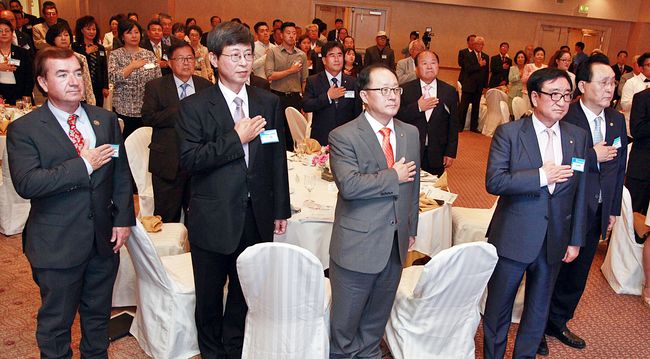
Two leading voices in international policy towards North Korea held a live discussion with approximately 120 attendees in an organized effort to foster a broader community of Korean-Americans with a deper understanding of the need for two Koreas’ potential reunification.
U.S. House of Representatives Foreign Affairs Committee chairman Ed Royce and South Korea’s National Unification Advisory Council executive vice chairman Yoo Ho-yeol spoke to a crowd of Korean-Americans at the Oxford Palace Hotel in Los Angeles on Monday to discuss the steps needed to bring peace to the strained inter-Korea relations for the ultimate goal of reunifying the two countries separated by the Korean War. North Korea, ruled by a secluded communist regime, and democratic South Korea ended the war in 1953 in an armistice, not a peace treaty.
The live discussion centered on various topics, including the effects of the U.S.-South Korea relations on North Korea. Royce emphasized the importance of potential Korean reunification for the sole purpose of ensuring human rights for average North Korean citizens.
“To find a solution for problems in North Korea, the U.S. is actively collaborating with nations around the world,” Royce said during the discussion. “It must be known to the North Korean regime that it must protect the human rights of its own people as well as making sure that its nuclear programs do not cause larger diplomatic issues.”
Royce added that he supports the U.S.’ plans to install the controversial missile system, known as Terminal High Altitude Area Defense (THAAD), in South Korea’s Seongju Province. The U.S indicated that the system must be deployed as a preventative measure to counter North Korea’s “missile threat.” China and Russia have since denounced the U.S.’ decision, suggesting that it is using conflicts on the Korean peninsula as a front to spy on them.
“I welcome the THAAD deployment from the standpoint of securing peace and safety on the Korean peninsula,” Royce said. “The U.S. has been actively collaborating with its allies around the world to find a solution for problems in North Korea. China, too, must choose to play an active role in helping to ensure human rights in North Korea.”
To say that Royce’s comments on the THAAD deployment will be controversial even among South Koreans would be an understatement. In fact, the decision to install the THAAD has already drawn strong protests from many South Koreans, who believe that the system’s radar has harmful effects on the health of the residents in the mountainous area of Seongju.
Since the U.S. and South Korea have agreed to station the defense system, North Korea has threatened to “retaliate” and has even said it will close its communication channel with the U.S. at the United Nations offices.
However, Yoo stood in line with Royce’s comments and suggested to the attendees at the live discussion that South Korea’s current policy under president Park Geun-hye is the “only solution” to trigger a change in North Korea.
“The tension between North and South Korea have risen significantly after the North conducted its fourth nuclear test in January,” Yoo said. “We can neither be dragged by North Korea nor accept its nuclear plans. The communication line between North and South Korea could reopen if the North gives up its nuclear program. Once that happens, both the U.S. and Japan can reestablish their relationship with North Korea as well.”
By Hyoung Jae Kim





